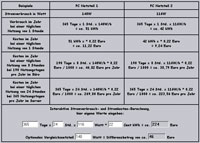
Power consumption of the ASRock Radeon RX 6600 CLD …
For the measurement, we use an energy cost meter from ELV as the power meter for this graphics card test.
We measured the power consumption of the entire system in both of our test scenarios and summarized it here.
| Test scenario | Power consumption |
| Idle | approx. 54.4 W |
| Default Mode Power Limit 100% | max. 197.8 W |
| User Mode OC Power Limit 120% | max. 229.3 W |
As the name suggests, we limit the maximum possible power consumption with the Power Limit. The 229.3 watts and the 31.5 watts difference are of course not permanent, but only a short peak. Nevertheless, you can clearly see that the 6-7% more power consumes more than average, even if we are “only” talking about a difference of about 30 watts in the end. Those who need the 6-7% more power for gaming, for example, will certainly not be deterred by the 16% higher peak power consumption.
A balanced OC setting with overclocking of the CPU and GPU, RAM, etc. under load and frugal power limits will pay off at the latest with the next power bill, as our PC power cost calculator shows very easily.
How high the power costs of the PC are with or without overclocking depending on the performance and daily running time can be calculated with our interactive PC power cost calculator:

Interactive power consumption Calculator
At this point, we would also like to mention that the graphics card did not produce any audible coil beeping. However, this can look completely different with an identical graphics card. The fan noise was also non-existent or only very moderate.
Now we come to our conclusion about the ASRock Radeon RX 6600 Challenger D 8G graphics card.
ASRock Radeon RX 6600 Challenger D 8G graphics card Result and general impression …


